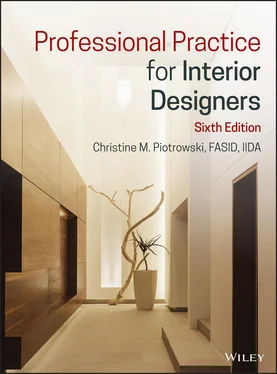Christine M. Piotrowski - Professional Practice for Interior Designers
Здесь есть возможность читать онлайн «Christine M. Piotrowski - Professional Practice for Interior Designers» — ознакомительный отрывок электронной книги совершенно бесплатно, а после прочтения отрывка купить полную версию. В некоторых случаях можно слушать аудио, скачать через торрент в формате fb2 и присутствует краткое содержание. Жанр: unrecognised, на английском языке. Описание произведения, (предисловие) а так же отзывы посетителей доступны на портале библиотеки ЛибКат.
- Название:Professional Practice for Interior Designers
- Автор:
- Жанр:
- Год:неизвестен
- ISBN:нет данных
- Рейтинг книги:4 / 5. Голосов: 1
-
Избранное:Добавить в избранное
- Отзывы:
-
Ваша оценка:
- 80
- 1
- 2
- 3
- 4
- 5
Professional Practice for Interior Designers: краткое содержание, описание и аннотация
Предлагаем к чтению аннотацию, описание, краткое содержание или предисловие (зависит от того, что написал сам автор книги «Professional Practice for Interior Designers»). Если вы не нашли необходимую информацию о книге — напишите в комментариях, мы постараемся отыскать её.
Professional Practice for Interior Designers
Professional Practice for Interior Designers — читать онлайн ознакомительный отрывок
Ниже представлен текст книги, разбитый по страницам. Система сохранения места последней прочитанной страницы, позволяет с удобством читать онлайн бесплатно книгу «Professional Practice for Interior Designers», без необходимости каждый раз заново искать на чём Вы остановились. Поставьте закладку, и сможете в любой момент перейти на страницу, на которой закончили чтение.
Интервал:
Закладка:
To some degree it might be argued that we ourselves have been responsible for this misconception. Interior designers can be bad businesspeople: giving away design ideas at initial meetings; being unconcerned about costs in running a business; and (frankly) letting the designer's ego get in the way of solving the client's problem. These kinds of behavior do not identify good businesspeople. The media contribute to this undervaluing of design as well, too often portraying interior design as easy or frivolous. And with so many people offering design and decorating services—many for free—why should clients value interior design?
Part of the problem arises because interior design is an intangible : it doesn't exist until after it is done. The only way that the clients can judge the quality of what they hope they will get is by seeing photos or drawings of work that the designer has done for someone else. They can feel a product; they can get comparisons online. Frequently the basis for judging the quality of what they will get from an interior designer is personal aesthetics—and that is very subjective.
As competition increases, designers have become more aware that they are not solely in the business of creating wonderfully aesthetic and functional interiors. Clients, including residential clients, are very interested in how the work of the interior designer will benefit them. Sometimes this is primarily a financial consideration. Sometimes this results in an interior that soothes the soul or creates a low carbon footprint, or provides a healthy place for the inhabitants. Interior designers can bring order out of chaos. They can bring psychological comfort to those traumatized by serious health issues. They can bring joy to children in a play area. And these do have value.
Thus, the interior designer must communicate his or her value and worth to a project on the basis of factors beyond how nice it will look at the end and the discount the client will get on furniture. The designer brings value because of his or her professional education, knowledge of how to make a space work better, be healthier, improve the users' comfort in the space, and, yes, look better.
The value of interior design also increases in the minds of clients as they see that the design community is committed to community service. Providing their problem‐solving skills to nonprofit organizations like the Ronald McDonald House shows the community that interior designers are not just interested in making money by selling expensive furniture. It shows the community that interior designers are interested in the community at large.
It is hard to argue the fact that most individuals who choose interior design as a profession do so to apply their creative and aesthetic skills and talents to interior spaces. Consequently, those projects arguably improve the aesthetics of residences and various commercial facilities. Nevertheless, the true value of interior design goes way beyond these traditional views. As interior designers know well, the colors chosen for an interior can create excitement or calm. The fabric chosen can reduce maintenance issues or explode them. The products themselves, if not chosen wisely, can sabotage basic safety in an emergency or emit poisonous and harmful fumes.
An individual I once worked with, at an office furnishings dealership, introduced the design department to a client by saying “and this is the icing on the cake—the design department.” Interior design is much more than icing, regardless of the space. The designer brings value to the client through his or her knowledge, experience, and skills gained through educational training and work experience. As you will read in depth in Chapter 2, these elements are critical keys to the advancement of the individual and the profession.
THE BUSINESS OF INTERIOR DESIGN
Not all designers get to work on multimillion‐dollar residences, mega‐hotels, or the latest celebrity chef's restaurant. The vast majority of interior designers work on smaller projects of various kinds. They help a family get a new home ready for occupancy and enjoyment. They remodel a franchise motel/hotel along the freeway. They give new life to a restaurant that needs a fresh look. They help seniors adjust their home environment to be more ergonomically friendly. Quite honestly, they might also simply specify new wall treatments, a few pieces of furniture, and stage a house for resale.
Interior design is all of these things and many more. It touches people in all walks of life and all economic positions. Also, it is a global profession: Interiors play a significant part in helping businesses succeed and people to feel comfortable in their homes throughout the world. Designers also increasingly seek out work in countries other than the United States. Many other countries desire the look of design that resides here. The amount of work done out of the United States by the largest firms continues to grow. 15
International design work is not something to seek without thought and planning. Even when it is a rather simple incursion due to an international client finding a designer's Web site and making a contact, saying a quick “yes” may not be the right answer. The designer must understand the business consequences of working internationally. When that client wants the designer to travel to the foreign country, the designer must have a good understanding of what it will mean to work out of the country. Chapter 3will discuss many issues related to working internationally.
It is important for the student and emerging professional interior designer to understand what it is like in the real world. This section presents some basic yet very important information to help readers understand that interior design is a business as well as a creative opportunity.
For a business to exist and (we hope) succeed, it must have at least three elements. First, it has to have people who are committed to operating and participating in the business. Second, it must have customers or clients who will purchase whatever the business provides in terms of services and possibly products. Third, it must have adequate financial resources for operation.
People
An interior design business starts with the owner committed to doing design work the way she thinks is right. The owner should have experience in the field before opening the doors. Many students think that once they have graduated from a program, they are automatically ready to open their own offices. Some do. Many fail and end up working for someone else.
When you read Chapter 19and the other chapters dealing with creating a design business, you will gain a deeper appreciation for what it is to be the owner of a design firm—even one whose only employee is the owner. There is a lot more to it than having a diploma, passing a licensing exam, and setting up an office.
There is risk involved in opening a business: financial risk, legal risk, and even risk in hiring employees. Employees—the people of the firm—must work as a team and must work in accordance with the rules the owner has set up. If you work for a sole practitioner or any small design firm, your willingness and ability to be a team player are crucial. Each individual in the company has a role on the team. Sometimes that role is not very glamorous. Not everything about interior design is glamorous.
As an employee, you need to remember that the firm does not belong to you. The owner, not you, makes decisions concerning how to go about doing a design project. The owners may veto work that you have spent hours doing with a wave of the hand. Guess what? It's their prerogative to do so, because it's their names on the door. Their risk is paramount to yours.
As the new person in the office, it is wise for you to keep your eyes and ears open; listen and observe what is going on. Each office has its way of doing things, and you need to learn those processes. Become a team player, and your experience opportunities will grow, just as your experience as a professional interior designer will grow.
Читать дальшеИнтервал:
Закладка:
Похожие книги на «Professional Practice for Interior Designers»
Представляем Вашему вниманию похожие книги на «Professional Practice for Interior Designers» списком для выбора. Мы отобрали схожую по названию и смыслу литературу в надежде предоставить читателям больше вариантов отыскать новые, интересные, ещё непрочитанные произведения.
Обсуждение, отзывы о книге «Professional Practice for Interior Designers» и просто собственные мнения читателей. Оставьте ваши комментарии, напишите, что Вы думаете о произведении, его смысле или главных героях. Укажите что конкретно понравилось, а что нет, и почему Вы так считаете.












